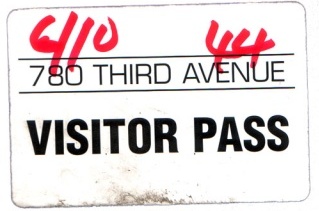 Rubbing the sleep from
my eyes, I squeeze the handset, wait for the beep, and then announce into
the ether, "P509 is clear at Bowery n Canal." Clouds pass overhead.
My LCD display flips to 09:54. "Sending three," my dispatcher
pipes out. Beep da beep. Beep da beep. Three text messages arrive on my
handset screen detailing the packet information: tracking number, customer,
caller, call time, pickup, delivery and item description. I jot key information
down on my clipboard manifest. Sweat glands ready their daily supply. Load
bag, spin bag round to back, unlock bike, swing 30 lbs chain lock round
torso and re-lock on waist, run with bike into traffic and hop on. Rubbing the sleep from
my eyes, I squeeze the handset, wait for the beep, and then announce into
the ether, "P509 is clear at Bowery n Canal." Clouds pass overhead.
My LCD display flips to 09:54. "Sending three," my dispatcher
pipes out. Beep da beep. Beep da beep. Three text messages arrive on my
handset screen detailing the packet information: tracking number, customer,
caller, call time, pickup, delivery and item description. I jot key information
down on my clipboard manifest. Sweat glands ready their daily supply. Load
bag, spin bag round to back, unlock bike, swing 30 lbs chain lock round
torso and re-lock on waist, run with bike into traffic and hop on.
Spinning down the avenue, my
mind flips between monitoring the flow of traffic and calculating my route.
All the systems established to control the moving sea of metal -- such
as traffic lights, lane markers, one way streets, and curbs -- are just
a series of suggestions at this point. As a data packet handler, it's
my job to find the best routes through my network. Two wheels trump four.
During new employee orientation, we were told to ride slow and smart,
not fast and dumb. In this world, network latency is a good thing. Being
smart means being connected -- linked by a telecom leash to my dispatcher.
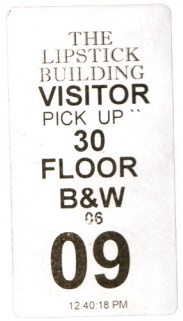 In his book Open Sky,
Paul Virilio describes this telecom-leashed existence as a 'body terminal,'
the omnipresent descendant of the territorial, mobile body. Data packet
handlers embody both of these characteristics. However, despite the on-demand
connection to my dispatcher, the protocols of the traffic network tend
to override the protocols of my dispatcher network where the sidewalk
ends and the lobby begins. While both systems seek an efficiency of flow,
the breakdown occurs where skin meets pavement, concrete, or even worse,
security. In his book Open Sky,
Paul Virilio describes this telecom-leashed existence as a 'body terminal,'
the omnipresent descendant of the territorial, mobile body. Data packet
handlers embody both of these characteristics. However, despite the on-demand
connection to my dispatcher, the protocols of the traffic network tend
to override the protocols of my dispatcher network where the sidewalk
ends and the lobby begins. While both systems seek an efficiency of flow,
the breakdown occurs where skin meets pavement, concrete, or even worse,
security.
If you consult Sweets,
the premiere US building products catalog, you will find a section named
10450 Pedestrian Control Devices dedicated to slowness. Amongst the items
listed are access doors, turnstiles, lighting and security systems. Most
of us have passed through enhanced security protocols at airports but
there is a new level of security arising in everyday workplaces in the
form of what I will call public furniture of control or PFoC's (pee-fox).
PFoC's are bossy cousins to the possibly more familiar street furniture
family of benches, sign posts, trash cans, etc.
Brake, swing right leg round to left, dismount. Fish out keys, swing lock
off hips and around bike, lock. Swing bag round front while walking to
pickup/drop address, pull out data packets and manifest. At most drops,
the address is wrong. The first layer of disconnecting between our protocols
is in the initial handshake. In Me++, William Mitchell describes connectivity
as the defining characteristic of the 21C urban condition and suggests
that we experience this connectivity with networks at their interface.
Sweat glands release their cache as the air-conditioned lobby envelops
my pores.
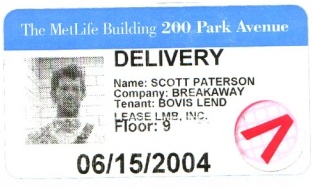 "Sorry, but you'll have
to go out that door, around the corner, door on left, etc." points
many a security guard. Thus begins the painful divergence between my on-demand
access-anywhere network and the network of PFoC's. Exit polished stone
lobby, round corner, enter side door/loading dock. Wait! "Photo ID
please." My first day on the job, a laminated mug shot for P509 was
issued. I was official. The security bouncer waves me through. Wait! "Photo
ID please." Another bouncer. Flash ID. "Up ramp to window, see
lady." "Sorry, but you'll have
to go out that door, around the corner, door on left, etc." points
many a security guard. Thus begins the painful divergence between my on-demand
access-anywhere network and the network of PFoC's. Exit polished stone
lobby, round corner, enter side door/loading dock. Wait! "Photo ID
please." My first day on the job, a laminated mug shot for P509 was
issued. I was official. The security bouncer waves me through. Wait! "Photo
ID please." Another bouncer. Flash ID. "Up ramp to window, see
lady."
"P509 into wait time 200
Park." Trod up ramp, see lady at desk with her own air conditioning.
I must be in the building now. "You been here before?" I nod.
"Step back." She kinks up a little outrigger with digital camera
from behind the counter. "Ok." Write company name, drop company
name, sign in 'guestbook.' Receive daily visitor sticker badge with photo
ID on it. On return trip no photo taken. Why? Because you are in their
database now. I'm in. If ever in doubt, being in the drop network means
being in air-conditioned slowness.
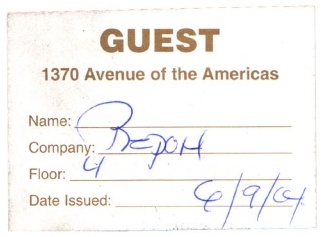 Thus begins a typical encounter
with PFoC's. They primarily exist on three scales -- mobile, body, and
surface. Examples of mobile units include customized temporary visitor
badges, swipe cards for turnstiles to elevator lobbies, and the security
bouncers, either roaming or stationed. Body scale units include (proceeding
from entry door to elevator door) bollards, door buzzers, Tensabarrier®
labyrinths, security desks, mechanical and electronic turnstiles, and/or
x-ray machines. Overseeing the entire theatre of inside/outside transitions
is a blanket of security cameras. One particularly glassy lobby has alternating
bird silhouettes on the glass and cameras on the mullions, a kind of bizarre
moebius strip of prevention. "Sign and print your name, please."
Express elevator down. Beep la boop. "Dropped 200 Park, two on board,
rollin' to Lex." Beep. "Roger that." Boop. Thus begins a typical encounter
with PFoC's. They primarily exist on three scales -- mobile, body, and
surface. Examples of mobile units include customized temporary visitor
badges, swipe cards for turnstiles to elevator lobbies, and the security
bouncers, either roaming or stationed. Body scale units include (proceeding
from entry door to elevator door) bollards, door buzzers, Tensabarrier®
labyrinths, security desks, mechanical and electronic turnstiles, and/or
x-ray machines. Overseeing the entire theatre of inside/outside transitions
is a blanket of security cameras. One particularly glassy lobby has alternating
bird silhouettes on the glass and cameras on the mullions, a kind of bizarre
moebius strip of prevention. "Sign and print your name, please."
Express elevator down. Beep la boop. "Dropped 200 Park, two on board,
rollin' to Lex." Beep. "Roger that." Boop.
PFoC's have grown to an architectural
scale. Every drop has at least two addresses. Depending on which network
I traverse, I use a different address. Data packets rarely go to the address
fixed in bronze, chrome, or granite despite the writing on the label.
Into the gulf of execution -- the potential gap in correspondence between
a user's intentions (drop a data packet) and a system's actions (addressing)
as described by Don Norman in "The Psychopathology of Everyday Things"
-- grows an increasing variety of architecture and furniture annexes.
PFoC's began as flexible spatial devices, but a Tensabarrier® labyrinth
can quickly become a messenger center, a co-located lobby of its own,
or a prison for the paperless. "Drop 230 Park."
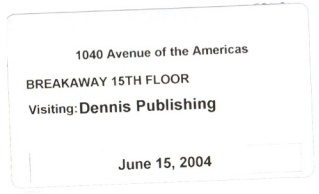 Ultimately, the increasing
permanence of PFoC's fosters the trend of privately owned public spaces.
Brandscaping replaces landscaping. Restricted physical access produces
exclusive visual exposure. Slowness and saturation are the mandates for
its design. A PFoC-encrusted raumplan (Loos) has replaced plan libre (Le
Corbusier). The Seagram and Lever House pilotis have barnacles. The limits
PFoCs impose on behavior snip the grass roots of the omnipresent terminal
body. The route between the network of suits and sweats is now an outsourced-overseen
interface where connectivity is granted only if you obey the ergonomics
of control. Beep la boop. "P509 clear with signatures." Ultimately, the increasing
permanence of PFoC's fosters the trend of privately owned public spaces.
Brandscaping replaces landscaping. Restricted physical access produces
exclusive visual exposure. Slowness and saturation are the mandates for
its design. A PFoC-encrusted raumplan (Loos) has replaced plan libre (Le
Corbusier). The Seagram and Lever House pilotis have barnacles. The limits
PFoCs impose on behavior snip the grass roots of the omnipresent terminal
body. The route between the network of suits and sweats is now an outsourced-overseen
interface where connectivity is granted only if you obey the ergonomics
of control. Beep la boop. "P509 clear with signatures."
References:
Paul Virilio, Open Sky (Verso Books: London, 1997)
William Mitchell, Me++ (The MIT Press: Cambridge, MA, 2003)
Sweets Catalog, www.sweets.com
Donald Norman, "The Psychopathology of Everyday Things"
in The Psychology of Everyday Things (Basic Books: New York,
1998)
|


 Rubbing the sleep from
my eyes, I squeeze the handset, wait for the beep, and then announce into
the ether, "P509 is clear at Bowery n Canal." Clouds pass overhead.
My LCD display flips to 09:54. "Sending three," my dispatcher
pipes out. Beep da beep. Beep da beep. Three text messages arrive on my
handset screen detailing the packet information: tracking number, customer,
caller, call time, pickup, delivery and item description. I jot key information
down on my clipboard manifest. Sweat glands ready their daily supply. Load
bag, spin bag round to back, unlock bike, swing 30 lbs chain lock round
torso and re-lock on waist, run with bike into traffic and hop on.
Rubbing the sleep from
my eyes, I squeeze the handset, wait for the beep, and then announce into
the ether, "P509 is clear at Bowery n Canal." Clouds pass overhead.
My LCD display flips to 09:54. "Sending three," my dispatcher
pipes out. Beep da beep. Beep da beep. Three text messages arrive on my
handset screen detailing the packet information: tracking number, customer,
caller, call time, pickup, delivery and item description. I jot key information
down on my clipboard manifest. Sweat glands ready their daily supply. Load
bag, spin bag round to back, unlock bike, swing 30 lbs chain lock round
torso and re-lock on waist, run with bike into traffic and hop on.